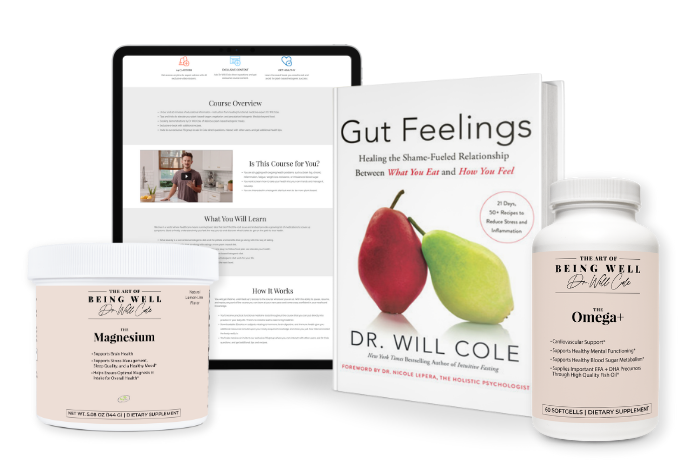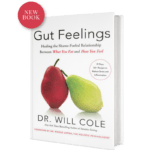The Fascinating Science Of CBD Oil & The Endocannabinoid System

CBD oil has exploded in the wellness world and can be found in everything from chocolate, to supplements, to beauty products. While it does have something to do with marijuana, you don’t need to worry about getting high. Let me explain.
The Basics of CBD Oil: Hemp vs. Marijuana
CBD stands for cannabidiol, which is a cannabinoid compound in hemp and marijuana. Both are part of the Cannabis plant family with the difference between the two being the level of another cannabinoid compound, THC. This is the most famous cannabinoid out of the 60 different types – it’s basically the Beyonce of cannabinoids. The reason it is so popular is because it is what gives you the psychoactive high associated with weed.
Without going into too much detail, marijuana contains higher levels of THC than hemp. Depending on the specific plant the oil was extracted from and the product, the ratio of CBD to THC in hemp oil can vary. CBD oil, is a concentrated form of the cannabidiol compound and is usually derived from hemp but in some cases can be extracted from marijuana also. You’ll find varying levels of THC and CBD in CBD oil products. Some contain small amounts of THC but most don’t have any.
ARTICLE CONTINUES BELOW
Make Your Life a Cleanse
SUBSCRIBER-ONLY GUIDES FOR GUT HEALTH, VIBRANT ENERGY, HEALTHY FOOD & CLEAN ALCOHOL
Get FREE access to these + giveaways, recipes, & discount codes in personal emails from Dr. Will Cole.
The Health Benefits of CBD Oil
While CBD oil won’t give you a high and a bad case of the munchies, people are still raving about this oil for improving their health. If THC is the Beyonce of cannabinoids, then CBD is the Adele: Both you and your grandma will love it. CBD is just as talented as THC but safe for the whole family and an increasing amount of research is showing just how powerful it can be for helping your health.
The main reason CBD has become so popular is due to its ability to naturally drive-down inflammation. Since chronic inflammation is the fuel behind so many modern day health problems it is no wonder why the benefits of CBD can be far-reaching. Even though inflammation is not bad, and actually necessary to help fight off infections and heal wounds, it can quickly get out of hand if it never subsides after the threat is gone. This is where CBD oil comes in to calm the fire that is ongoing inflammation.
CBD oil, Inflammation + Anxiety
It is estimated that 30 percent (1) of adults in America – 66 million people – suffer from anxiety disorders, making it one of the most common mental health problems in the United States. That is not even including the close to 25 percent of preteens and teenagers struggling with anxiety. As a functional medicine practitioner, anxiety is something I see all too often. But just because something is common doesn’t mean it is normal. Thankfully, science is starting to discover more about how anxiety begins which will help develop more effective treatment options.
It is easy to separate mental health from physical health. However, research is finding that inflammation is the common contributing factor between brain health problems such as anxiety, brain fog, depression, autism, ADD, and ADHD. In fact, an entire area of research known as the cytokine model of cognitive function is dedicated to looking at how inflammation affects the brain and can contribute to anxiety disorders. It was found that increased levels of the inflammatory bad guy, NF kappa B (NFkB), is associated with anxiety while on the other hand, lower levels of NFkB are associated with lower rates of anxiety. (2)
Enter CBD oil. I have seen not only in my patients’ life, but my own life as well, the powerful impact CBD oil can have on anxiety. Multiple studies have found CBD oil to be an effective treatment for social anxiety (3) and is a natural anxiolytic (anxiety calmer). (4) CBD oil has all the benefits of anti-anxiety medications without the side effects.
CBD oil can also reduce anxiety (5) by increasing prefrontal cortex activation and lowering activity in the amygdala – two areas of the brain involved in anxiety. Evidence also suggests that CBD can activate hippocampus neurogenesis (6) to regenerate new neurons! This works to activate CB1 receptors that balance GABA and glutamate levels to reduce anxiety.
A fair amount of research has posed CBD as a possible treatment for inflammatory conditions such as autoimmune conditions, as well. In fact, the authors of one review article (7) titled, “Cannabinoids as novel anti-inflammatory drugs” even wrote: “Manipulation of endocannabinoids and/or use of exogenous cannabinoids in vivo can constitute a potent treatment modality against inflammatory disorders.”
If you’re wondering how CBD seems to tackle chronic inflammation, you’re not alone. Researchers are also trying to figure that out at this very moment. One of the main theories is that CBD can induce T-reg cells, (8) the immune cells responsible for finding and eliminating bacteria, viruses, and other outside invaders. When inflammation is at its worst, T-reg cells lose the ability to distinguish between these invaders and the body itself, which leads to an immune system that attacks its own tissues. This causes autoimmune disease, of which there are more than 100 (9) different kinds.
CBD Oil: How Much Should You Take?
Research surrounding CBD oil suggest a wide dosage range from anywhere between a few milligrams to hundreds of milligrams. I suggest starting off small, around 10 milligrams, and gradually increase over a few weeks or a few months to see how your body responds and what works best for you. Another option is to split the dose during the day instead of taking it all at one time. With anything, it is important to discuss this with your doctor especially if you are currently taking any medications. In general CBD oil is safe for most people but it can possibly interact with and decrease or increase certain drugs’ effectiveness.
There are many great quality CBD oils available but it is essential to make sure you are buying a product from organically grown hemp that has been third-party tested for potency and quality. Cannabis is a bioaccumulator, (10) which means it absorbs toxins from the soil, so you want to make sure you’re not ingesting any chemicals - that might actually contribute to inflammation - along with your CBD.
The Endocannabinoid System
But why and how exactly does CBD seem to work so well, for so many different conditions? Cannabidiol (CBD) interacts with a larger system in the body called the endocannabinoid system, which explains the science behind many of its health benefits.
What’s the endocannabinoid system?
So what is the endocannabinoid system (ECS), exactly? It’s a network of receptors, enzymes, and compounds that the body naturally produces, called endocannabinoids. It’s often described as the body’s “master regulatory system” and is in charge of maintaining homeostasis, which is just another word for maintaining balance between internal and external environments.
The ECS has been connected to so many aspects of our health - including our moods, stress and pain response, and even seemingly unrelated factors like fertility issues and headaches. (Like I said, so many.)
How does CBD affect the ECS?
The two main endocannabinoids in the body are anandamide (AEA) and 2-arachidonoylglyerol (2-AG). Your ECS has receptors for each of these endocannabinoids throughout your body and when an endocannabinoid binds to a receptor, it prompts your ECS to keep various body functions running optimally. There are two main types of ECS receptors: CB1 receptors, located mainly in your central nervous system, and CB2 receptors, located mainly in your peripheral nervous system and immune system.
It’s thought that taking cannabinoids from plants - which are known as phytocannabinoids - can help restore balance to an endocannabinoid system that’s not working efficiently. Health experts have even coined the terms “low endocannabinoid tone” and “clinical endocannabinoid deficiency” to describe an endocannabinoid system that’s gone a little haywire. But what are the real consequences of a low endocannabinoid tone? Just to name a few, an unhealthy ECS has been linked to conditions like autism, (11) migraines, fibromyalgia, and irritable bowel syndrome. (12) We’ll likely uncover many more as the research surrounding the ECS expands and grows.
But taking cannabinoids like CBD isn’t the only way to support your ECS. As it turns out, your diet and lifestyle matter, and matter a lot.
How do you support your endocannabinoid system?
We’re learning more and more that specific dietary and lifestyle changes can support the health of the ECS every day. But why would you want to change your lifestyle when you can just pop a CBD gummy and call it a day? As it turns out, the better you support your ECS, the more effective your hemp and CBD products will be.
Here are 10 quick and easy ways to improve the functioning of your endocannabinoid system:
1. Get some sun
We all know that sun exposure is great for your mood and vitamin D levels, but it also enhances your ECS activity since the sun’s rays promote (13) nitric oxide activity, which bolsters the expression of CB1 receptors.
2. Drink plenty of tea
Who doesn’t love a cold glass of iced tea? Tea is chock full of antioxidants - like the compound epigallocatechin gallate (EGCG) found in green tea - that enhance (14) the endocannabinoid system. They do this by binding to cannabinoid receptors in the central nervous system.
3. Eat plenty of healthy fats
Good fats are a non-negotiable part of a healthy diet and a healthy ECS. The body’s endocannabinoids are actually synthesized (15) from the omega-6 fatty acid arachidonic acid. Make sure you’re eating a healthy ratio of omega-3 and omega-6 fatty acids, which you can find in foods like chia seeds, eggs, flaxseeds, hemp seeds, salmon, and wild-caught sardines.
4. Get chilly
Cold exposure has been shown (16) to stimulate (17) the endocannabinoid system (and boost metabolism!). Try taking cold showers or swimming in cold water if you live near a body of water. Your ECS will thank you.
5. Go crazy on the vitamin A
Studies have shown that vitamin A increases CB1 expression. (18) And the good news is that you can find this vitamin in a variety of delicious, satiating foods, including wild-caught fish and ghee.
6. Get serious about reducing stress
The stress hormone cortisol can reduce (19) hippocampal CB1 receptors in the brain, which has been linked to low endocannabinoid tone. To combat this, get plenty of sleep, take time to wind down at the end of the day, and adopt a mindfulness practice like journaling, meditation, or yoga.
7. Make sure you’re well-hydrated
Many people don’t realize it, but hydration involves way more than just water. It’s also crucial to get electrolytes, like magnesium, calcium, and potassium, to stay properly hydrated. These minerals have the additional job of keeping your body’s pH levels healthy and research has shown (20) that calcium and potassium boost CB1 transport and activity.
8. Avoid ECS saboteurs
It only makes sense that if some factors can improve the health of the ECS, others can hinder it. Pesticides and chemicals are on that list. Research has shown these pesky toxins can block the activity (21) of the endocannabinoid system. To reduce your exposure, buy organic produce (especially when it’s on the Dirty Dozen list) and store your food and water in glass and stainless steel instead of plastic.
9. Move your body
The ECS appreciates your efforts to work out as much as any other part of your body! Research suggest that exercise can both increase levels of your natural CB1 activator, anandamide, (22) as well as your CB1 receptor sensitivity. (23)
10. Treat yourself
Dark chocolate can support the natural endocannabinoid anandamide, as well as compounds that slow the breakdown of this endocannabinoid, which helps stimulate your endocannabinoid system.
So there you have it! Ten easy ways to make sure your ECS is running as smoothly as possible and that your CBD is really able to do its job.
As one of the first functional medicine telehealth clinics in the world, we provide webcam health consultations for people around the globe.
Photo: Stocksy
Start Your Health Journey Today
FUNCTIONAL MEDICINE CONSULTATIONS FOR PEOPLE AROUND THE WORLD
References:
- Facts & Statistics Anxiety and Depression Association of America https://adaa.org/about-adaa/press-room/facts-statistics
- Kassed CA, Herkenham M. NF-kappaB p50-deficient mice show reduced anxiety-like behaviors in tests of exploratory drive and anxiety. Behav Brain Res. 2004;154(2):577‐584. doi:10.1016/j.bbr.2004.03.026
- Crippa JA, Derenusson GN, Ferrari TB, et al. Neural basis of anxiolytic effects of cannabidiol (CBD) in generalized social anxiety disorder: a preliminary report. J Psychopharmacol. 2011;25(1):121‐130. doi:10.1177/0269881110379283
- Bergamaschi MM, Queiroz RH, Chagas MH, et al. Cannabidiol reduces the anxiety induced by simulated public speaking in treatment-naïve social phobia patients. Neuropsychopharmacology. 2011;36(6):1219‐1226. doi:10.1038/npp.2011.6
- Hill MN, Patel S. Translational evidence for the involvement of the endocannabinoid system in stress-related psychiatric illnesses. Biol Mood Anxiety Disord. 2013;3(1):19. Published 2013 Oct 22. doi:10.1186/2045-5380-3-19
- Campos AC, Ortega Z, Palazuelos J, et al. The anxiolytic effect of cannabidiol on chronically stressed mice depends on hippocampal neurogenesis: involvement of the endocannabinoid system. Int J Neuropsychopharmacol. 2013;16(6):1407‐1419. doi:10.1017/S1461145712001502
- Nagarkatti P, Pandey R, Rieder SA, Hegde VL, Nagarkatti M. Cannabinoids as novel anti-inflammatory drugs. Future Med Chem. 2009;1(7):1333‐1349. doi:10.4155/fmc.09.93
- Dhital S, Stokes JV, Park N, Seo KS, Kaplan BL. Cannabidiol (CBD) induces functional Tregs in response to low-level T cell activation. Cell Immunol. 2017;312:25‐34. doi:10.1016/j.cellimm.2016.11.006
- There are more than 100 Autoimmune Diseases American Autoimmune Related Diseases Association, Inc. https://www.aarda.org/diseaselist/
- Alice Mead J.D. LL.M. The legal status of cannabis (marijuana) and cannabidiol (CBD) under U.S. law Epilepsy & Behavior Volume 70, Part B, May 2017, Pages 288-291 doi:10.1016/j.yebeh.2016.11.021
- Aran A, Eylon M, Harel M, et al. Lower circulating endocannabinoid levels in children with autism spectrum disorder. Mol Autism. 2019;10:2. Published 2019 Jan 30. doi:10.1186/s13229-019-0256-6
- Russo EB. Clinical Endocannabinoid Deficiency Reconsidered: Current Research Supports the Theory in Migraine, Fibromyalgia, Irritable Bowel, and Other Treatment-Resistant Syndromes. Cannabis Cannabinoid Res. 2016;1(1):154‐165. Published 2016 Jul 1. doi:10.1089/can.2016.0009
- Molina-Holgado F, Molina-Holgado E, Guaza C, Rothwell NJ. Role of CB1 and CB2 receptors in the inhibitory effects of cannabinoids on lipopolysaccharide-induced nitric oxide release in astrocyte cultures. J Neurosci Res. 2002;67(6):829‐836. doi:10.1002/jnr.10165
- G.Korte, A.Dreiseitel, P.Schreier, A.Oehme, S.Locher, S.Geiger, J.Heilmann, P.G.Sand, Tea catechins’ affinity for human cannabinoid receptors Phytomedicine Volume 17, Issue 1, January 2010, Pages 19-22 doi:10.1016/j.phymed.2009.10.001
- Dyall SC. Interplay Between n-3 and n-6 Long-Chain Polyunsaturated Fatty Acids and the Endocannabinoid System in Brain Protection and Repair. Lipids. 2017;52(11):885‐900. doi:10.1007/s11745-017-4292-8
- Lucia M. Krott, Fabiana Piscitelli, Markus Heine, Simona Borrino, Ludger Scheja, Cristoforo Silvestri, Joerg Heeren, and Vincenzo Di Marzo Endocannabinoid regulation in white and brown adipose tissue following thermogenic activation Journal of Lipid Research March 2016. 57, 464-473. doi: 10.1194/jlr.M065227
- Lahesmaa M, Eriksson O, Gnad T, Oikonen V, Bucci M, Hirvonen J, Koskensalo K, Teuho J, Niemi T, Taittonen M, Lahdenpohja S, U Din M, Haaparanta-Solin M, Pfeifer A, Virtanen KA, Nuutila P. Cannabinoid Type 1 Receptors Are Upregulated During Acute Activation of Brown Adipose Tissue. Diabetes. 2018 Jul;67(7):1226-1236. doi: 10.2337/db17-1366. Epub 2018 Apr 12.
- Korecka JA, van Kesteren RE, Blaas E, et al. Phenotypic characterization of retinoic acid differentiated SH-SY5Y cells by transcriptional profiling. PLoS One. 2013;8(5):e63862. Published 2013 May 28. doi:10.1371/journal.pone.0063862
- Agrawal A, Nelson EC, Littlefield AK, et al. Cannabinoid receptor genotype moderation of the effects of childhood physical abuse on anhedonia and depression. Arch Gen Psychiatry. 2012;69(7):732‐740. doi:10.1001/archgenpsychiatry.2011.2273
- Khasabova IA, Simone DA, Seybold VS. Cannabinoids attenuate depolarization-dependent Ca2+ influx in intermediate-size primary afferent neurons of adult rats. Neuroscience. 2002;115(2):613‐625. doi:10.1016/s0306-4522(02)00449-9
- Quistad GB, Nomura DK, Sparks SE, Segall Y, Casida JE. Cannabinoid CB1 receptor as a target for chlorpyrifos oxon and other organophosphorus pesticides. Toxicol Lett. 2002;135(1-2):89‐93. doi:10.1016/s0378-4274(02)00251-5
- Fuss J, Steinle J, Bindila L, et al. A runner's high depends on cannabinoid receptors in mice. Proc Natl Acad Sci U S A. 2015;112(42):13105‐13108. doi:10.1073/pnas.1514996112
- De Chiara V, Errico F, Musella A, et al. Voluntary exercise and sucrose consumption enhance cannabinoid CB1 receptor sensitivity in the striatum. Neuropsychopharmacology. 2010;35(2):374‐387. doi:10.1038/npp.2009.141
View More At Our Store
Purchase personally curated supplements
and Dr. Will Cole’s books!

The information on this website has not been evaluated by the Food & Drug Administration or any other medical body. We do not aim to diagnose, treat, cure or prevent any illness or disease. Information is shared for educational purposes only. You must consult your doctor before acting on any content on this website, especially if you are pregnant, nursing, taking medication, or have a medical condition.
Our content may include products that have been independently chosen and recommended by Dr. Will Cole and our editors. If you purchase something mentioned in this article, we may earn a small commission.

BY DR. WILL COLE
Dr. Will Cole, DNM, IFMCP, DC is a leading functional medicine expert who consults people around the globe, starting one of the first functional medicine telehealth centers in the world. Named one of the top 50 functional and integrative doctors in the nation, Dr. Will Cole provides a functional medicine approach for thyroid issues, autoimmune conditions, hormonal imbalances, digestive disorders, and brain problems. He is also the host of the popular The Art of Being Well podcast and the New York Times bestselling author of Intuitive Fasting, Ketotarian, Gut Feelings, and The Inflammation Spectrum.

Gut Feelings
Healing The Shame-Fueled Relationship
Between What You Eat And How You Feel


